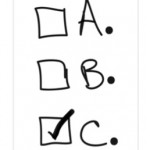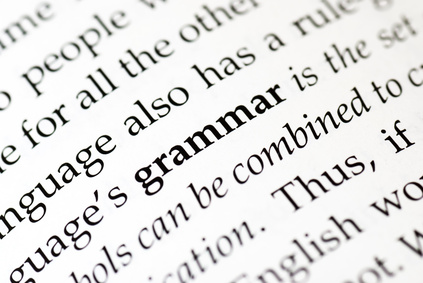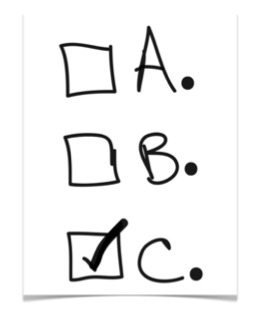While you’re here, join my pro tutor’s perfect-score SAT email list and I’ll send you subscriber-only bonuses to help you prepare for the SAT!
The SAT Writing section splits broadly into two areas of study:
1) The rules of English grammar and style (tested via 49 multiple-choice question)
2) Rhetorical skills (tested via a 25-minute timed essay on a “random” topic)
Because the SAT is a “standardized” test, the SAT Writing topics are very easily predicted.
This is great news for anyone who wants to study up – I can tell you exactly what topics you will be tested on, and you can go study them to improve your score!
I’m going to give you a preview of all these skills, but if you really want to get started improving, you should buy and download my two e-books on the SAT Writing section:
1) Top 12 SAT Writing Grammar Rules
2) Top 30 Examples to Use as SAT Essay Evidence
I recommend buying those e-books today; I guarantee you will find them helpful, as many students before you have. But, if you’re not quite ready to purchase those books and practice the most important SAT Writing topics, here’s a preview of what’s inside.
1: The rules of English grammar and style (SAT Writing Multiple-Choice Topics)
Get Exclusive SAT Prep Tips!
I want to send you more tips to help your SAT score, but I need your email address to stay in touch. Enter your email below so I can send you my reports on the SAT and other subscriber-only bonuses.
These are the rules tested via multiple-choice questions on Sentence Improvement, Error Identification, and Improving Paragraphs.
1) Subject-Verb Agreement: The most common topic on the SAT Writing section, and one of the most devious. You must be able to identify the subject and main verb of any sentence. You must also know if the subject is singular or plural, and if the main verb is singular or plural. Subject and main verb MUST match in singular/plural. The SAT has many tricks to make this grammar error harder to identify.
2) Pronoun Number: Much like subject-verb agreement. You must be able to identify the pronouns in a sentence, determine what noun they are replacing, and ensure that they match that noun in terms of singular/plural number.
3) Sentence Fragments: Sentence fragments are incomplete sentences that lack a main verb, or (less commonly) have a main verb but lack a subject.
4) Comma Splices: Often called “run-on sentences.” This error is usually caused by using a comma when a period or semicolon is needed. If a sentence contains two complete ideas (or “independent clauses”), then a comma is not enough to connect them. There are three ways to fix comma splices – with a period, semicolon, or conjunction like “and” or “but.”
5) Parallelism: A tricky rule that most students need to learn and practice. Essentially, this grammar topic is about the importance of keeping “patterns” going the same way they started. You can’t say “I like running, jumping, and to swim” because the pattern started with “-ing” verbs and switched to “to swim” at the end – the pattern is broken. It can get a lot more complicated – make sure to study this SAT Writing topic if you want to improve your score.
6) Misplaced Modifiers: My favorite SAT Writing topic, because these sentences turn out really amusing. This is when a descriptive phrase (or “modifier”) isn’t next to the noun it’s describing, with comical results. For example, “Straining at his leash, the owner could not control his new puppy” makes it sound like the owner is “straining at his leash,” when we know the puppy would actually be on the leash.
7) Illogical Comparison: A sub-topic of parallelism. You can’t compare two things that aren’t the same; the textbook example is “The San Diego zoo has more animals than any other city.” Notice the comparison (number of animals)? Notice how a “zoo” is compared to all other “cities”? It’s not logical to compare these two things to each other. “Any other city’s zoo” would work, though.
8) Pronoun Case: “Me went to the park” sounds horrible, right? Pronoun Case is the SAT Writing topic that deals with that sort of stuff. It can get a lot trickier to notice this mistake, though, so you need to learn an essential strategy that will always help figure this topic out. Check out this article and my Top 12 Grammar Rules e-book.
9) Conjunctions: Conjunctions are the words that link two ideas, like “and,” “because,” “therefore.” The most important thing is that the linking word is logical.
10) Passive Voice and Wordiness: As a rule of thumb, the SAT Writing section frowns on excess wordiness, redundancy, etc. The passive voice is generally unnecessary and just adds words when the sentence could be made simpler. The shortest answer without any mistakes is frequently the correct answer.
11) Adverbs and Adjectives: Adjectives describe things/nouns. Adverbs describe everything else/adjectives/verbs/other adverbs. They are not interchangeable. About 99% of adverbs end in “-ly,” which makes them easy to identify.
12) Relative Pronouns: The word “where” is only for locations. The word “when” is only for time periods. “Who” is only for people. “That” and “which” have specific uses. Make sure you know them.
13) Word Pairs: “Neither…nor” goes together. “Either… or” goes together. “Both… and…” and “as…as…” go together. A minor writing topic, but one that’s easy to spot and gain points from.
14) Idioms: The bane of my existence as a tutor. There’s no time-effective way to study these, other than doing a lot of high-quality free reading. Why do we “look something up” in a dictionary, instead of “looking it down“? There’s no good reason – it’s just “what we say” because we say it. Don’t sweat these too much; just be aware they’re on the test.
15) Verb Tenses: If you’re talking about an event from the past, you need the past tense, etc. A sentence isn’t necessarily wrong just because it has more than one verb tense inside it, but you must carefully trace the time periods under discussion and make sure the right tenses are being used when appropriate.
16) Pronoun Ambiguity: If you have a sentence with three different women in it, and the pronoun “she” is used without making it clear which of the three women it refers to, this is a “pronoun ambiguity error.” I hate pronouns in real life, because I never know who or what anyone is talking about (“It was really cool” doesn’t mean anything to me!! What is “it”??) The SAT Writing section feels the same way I do.
17) Paragraph Organization: If you’re improving paragraphs, make sure each paragraph is as on-topic as possible. It should not jump around from topic to topic. Keep things nice and organized (this goes for your own essay as well).
18) Logical Flow: Again, in the Improving Paragraphs section, make sure that each sentence flows logically into the next sentence, and that each paragraph connects nicely to the paragraphs before and after it. Your goal should be to make life very easy for the reader. Like #17, this SAT Writing topic goes double for your own SAT essay.
2: Rhetorical Skills and Essay Writing
You only have 25 minutes to write your SAT essay, so it’s not expected to be a masterwork. You should focus on fulfilling these general guidelines:
A) Stay on topic and stay organized. Answer the question you were asked.
B) Keep a clear side. 25 minutes is not enough time to argue out of both sides of your mouth. The grader should know from start to finish what your point is.
C) Use specific evidence. That link will take you to my e-book on 30 great examples to pick from for your SAT essay. You should prepare at least 5 different examples. If you don’t want to buy the book (even though it’s really cheap and people love it), you can get an idea of what I’m talking about by checking out 5 Historical Examples for the SAT Essay.
D) Do a solid brainstorm (about 3-4 minutes) before you start writing. This will make your SAT essay far more organized and convincing. Think about the points you’re going to make, and organize them logically, before you just start writing gibberish.
E) Write as much as possible, without just using fluff or repeating yourself. Longer essays typically receive higher scores.
F) Use your best handwriting. Believe me, it’s NOT fun to read an essay with crappy, cramped handwriting, and it makes me want to give that essay a very low score out of rage. Do yourself a favor and write neatly.
G) Don’t sweat it. The essay is a relatively small fraction of your overall SAT Writing score. This is a near-comprehensive list of the topics on the SAT Writing section, from grammar multiple-choice to essay writing.
There might be a few tiny scraps that I’ve left out, but by and large, this is everything you will have to deal with.
Remember that it’s a STANDARDIZED test, which means they can’t throw you any surprises or curveballs.
Make sure you practice with my Top 12 SAT Writing Grammar Rules e-book!
Further Reading:
Top 5 Best SAT Writing Prep Books
Introduction to SAT Writing Multiple-Choice
SAT Writing Rules: Subject-Verb Agreement
What is the SAT Essay?
Top 10 Tips for the SAT Essay
Additional Resources:
SAT Grammar Crammer: Top 12 Rules of SAT Writing (e-Book)
Top 30 Examples to Use as SAT Essay Evidence (e-Book)
Write the Best SAT Essay of Your Life! (e-Book)
Wait – before you leave, be sure to join my SAT prep email list! I send my subscribers test-prep bonuses and exclusive score-raising info not available anywhere else.


















Find Me on Social Media